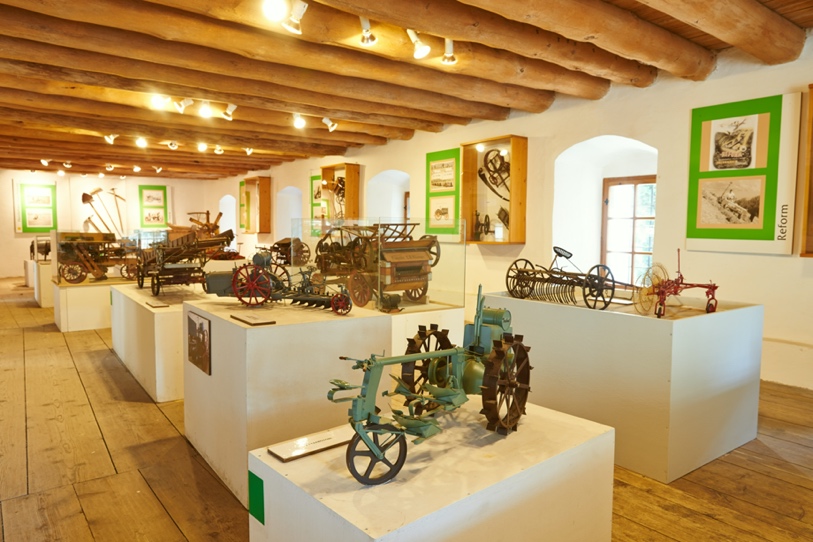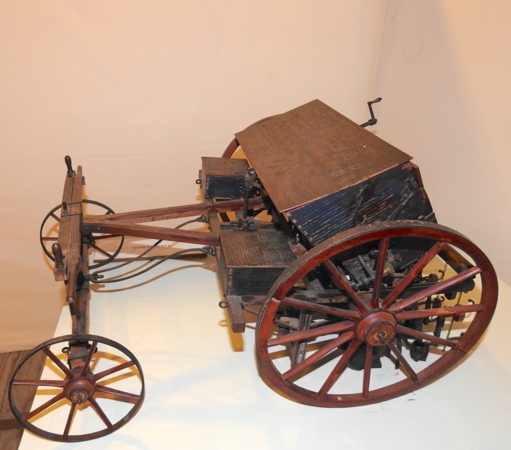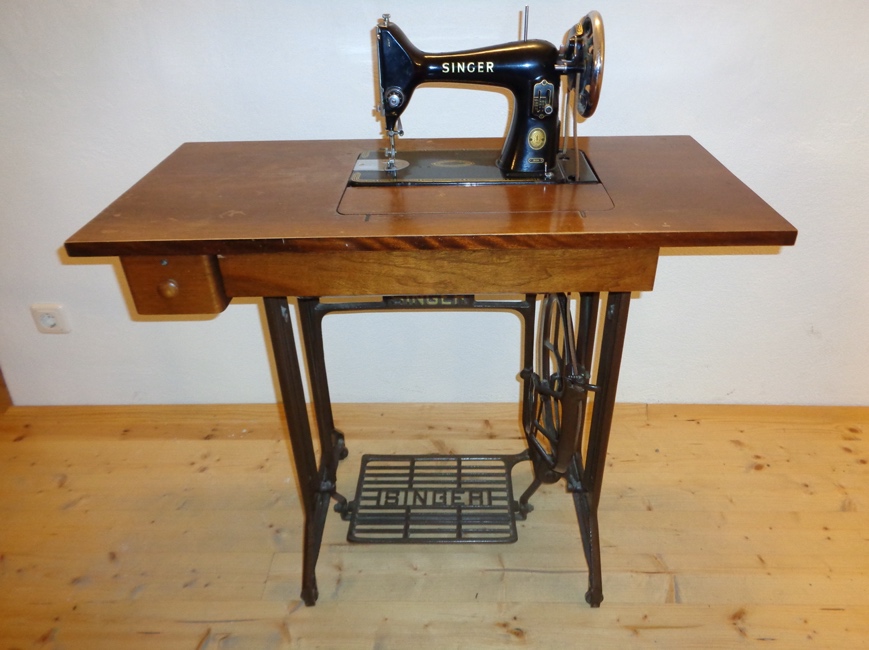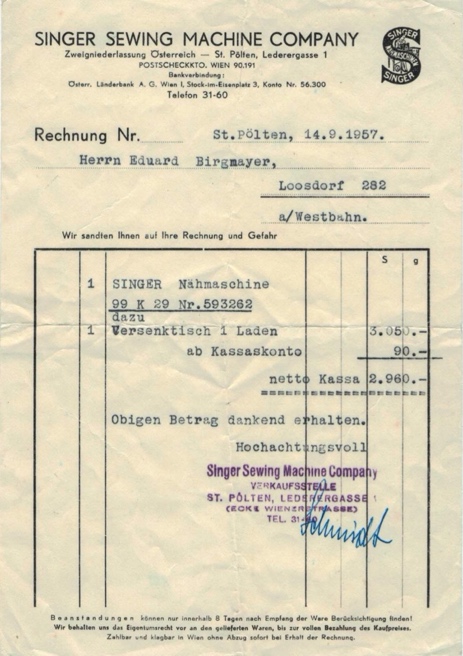
The market town of Leiben founded the museum in 1991, two years after purchasing the castle from the Austrian Forest Authority. The founding act itself created a museum, but the people and associations in the background bring it to life. On four floors, visitors will learn a lot about agriculture and agricultural machinery.

The major contributor for the ÖLM in Leiben is the association “Historische Landtechnik Österreich” HLTÖ (Historical Agricultural Machinery Austria), whose members take care of the exhibits, guide visitors and organize special events in the museum. Visitors will discover many agricultural exhibits on a surface of around 1,000 m². Some of these exhibits are dedicated to special topics:
Tractors Exhibition
Located In the basement, which is accessible for tractors, this exhibition displays more than 30 tractors which have played an important role in the history of agricultural machinery. They belong to members of the HLTÖ. They are landmarks that stand for the engineering development of agricultural tractors from 1920 to 1960. All tractors are ready to work and many of them have been restored completely. They are brought out of the exhibition halls for special events and sometimes for road trips organized by the HLTÖ.
Displays and information boards show the economic and engineering background of the machines on show.

Models of Success
This show of models of agricultural machinery is located on the first and second floors of the west wing of the castle. This is a collection of the so called “Hohenheim Models”, provided by the BOKU (The University for Agricultural Sciences in Vienna) as a permanent loan. The Hohenheim model manufactory was a well-known site for agricultural engineering throughout all of Europe in the 19th century. Some of these models came into the possession of the Habsburg Monarchy and triggered some important engineering developments in the country. Many of the models have survived and were used in schools for a long time. The ÖLM is thus the home of the largest collection of such true-to-scale replicas of historical agricultural equipment in Austria.

Help after Defeat

A special and probably unique show in Europe can also be found on the second floor of the castle.
It deals with UNRRA Aid (United Nations Relief and Rehabilitation Administration) and the Marshall Plan. Both measures helped the European states to recover economically after the end of WWII in 1945. Aid was offered to 16 countries, including some in Eastern Europe. The idea of the Marshall Plan is still relevant today. This dictum for support in economic development is regularly found in political debates dealing with the management of major crises after war, climate or health events. The exhibition in the ÖLM shows the visitor details of the Marshall Plan and who benefited from it in Austria.

The Right Weight
The result of an extensive collector‘s passion will be found on the third floor. Eduard Sykora has collected scales of all shapes and sizes from 70 countries around the world for decades, for example,
balance scales or sliding weight scales. You will find these and many other devices for determining the Right Weight here in Leiben. The Viennese typesetter and globetrotter Eduard Sykora created a unique overview in this area of technology. His collection contains over 1,000 scales from all over the world. For this reason the exhibition “The Right Weight” is probably one of the largest on this topic and it is well worth taking a closer look at the subject.

Tillage
The history of tillage from the hand ax to the steam plow is shown in the rooms on the fourth and on the top floor. People who are nowadays less and less familiar with agricultural work and practices can see the increasing importance of a systematic and increasingly mechanized agriculture in feeding humankind. Our goal is to raise awareness and appreciation of the public for agriculture and its basic products.

Cooperation with the DLM Blankenhain
A cooperation between the ÖLM Europaschloss Leiben and AIMA member DLM Schloss (German Agricultural Museum) Blankenhain started in 2019. The cooperation has been especially active through regular meetings on both sites, the exchange of exhibits, articles for the annual publication of the DLM and with the organization of special exhibitions.

Special exhibition „Wia‘s früha amoi woa“ (“The way it used to be”)

The first result of the cooperation between the Austrian Agricultural Museum Europaschloss Leiben and the German Agricultural Museum Schloss Blankenhain was this special exhibition. It especially highlights developments in agriculture after WWII.
This was an exciting time for farmers because of the radical change of working methods within a few years thanks to mechanization. Manpower was the most important factor in farm work before this period. After 1945, a complete change took place due to mechanization. Maids and servants disappeared from farms within 20 years, and the same happened to draft oxen and horses. Manual grain harvesting was replaced by the combine harvester, green fodder production with a scythe was only continued on the steep alpine meadows after this time. The manual pull saw became obsolete in the forest and was replaced by the chainsaw. You can discover an overview of this crucial period in this special exhibition.
Special Story of an Exhibit
As you can see, agricultural machinery is not the only topic of the ÖLM. It also deals with rural life and its background throughout history. You will find the short story of a special exhibit below as an example for the various facets of rural life shown in the ÖLM.
Story of a Singer sewing machine.

This sewing machine produced by probably the most famous sewing machine-maker with origins in the USA has a very special background which is also a story about the shift of values through the decades. The Singer 99K model (built in 1957) was owned by Maria and Eduard Birgmayer and donated to the ÖLM and HLTÖ by Maria`s and Eduard´s heirs Helmut Birgmayer and Maria Pils.
Maria and Eduard lived in Gerersdorf near St. Pölten. They owned a plot of land of 1048 square meters in this village that was to be used as a site to build houses on. As Maria needed a sewing machine, the family decided to sell that plot of land for 4,800 Shillings to get the money to buy the Singer sewing machine for 2,960 Shillings. So the Birgmayer family got one sewing machine and 1,840 Shillings to use for other purposes from the land they sold.
In the present day, a similar plot of land would cost around 100,000 Euros. In contrast, a modern Singer sewing machine with more functions than the old 99K model sells at upwards of 200 Euros. So, with the money from selling such a plot of land, the Birgmayer family could buy up to 500 sewing machines today!
| Plot of 1048 m2 | Sewing machine | Number of Sewing machines | |
| 1957 | 4.800 ÖS | 2.960 ÖS | 1,6 |
| today | 100.000 € | 200 € | 500 |

The intention of the donors Helmut Birgmayer and Maria Pils was to make visitors think about how the values of goods and land have changed over the last 65 years when they see the sewing machine presented in the rooms of the ÖLM.

Come and visit the ÖLM
Passing by down on the road to the north, looking up at the mountain outcrop, you might be thinking – just another castle, so keep on going – you will never imagine how much knowledge and history is shown here in the ÖLM and also in the castle itself with its 900 years of history. In addition, there is a high level of expertise about historical agricultural machinery in Leiben, which is found in very few other places in Austria.
Translated from material by the board of the ÖLM, with additional material on the sewing machine by Albert Kühnstetter
